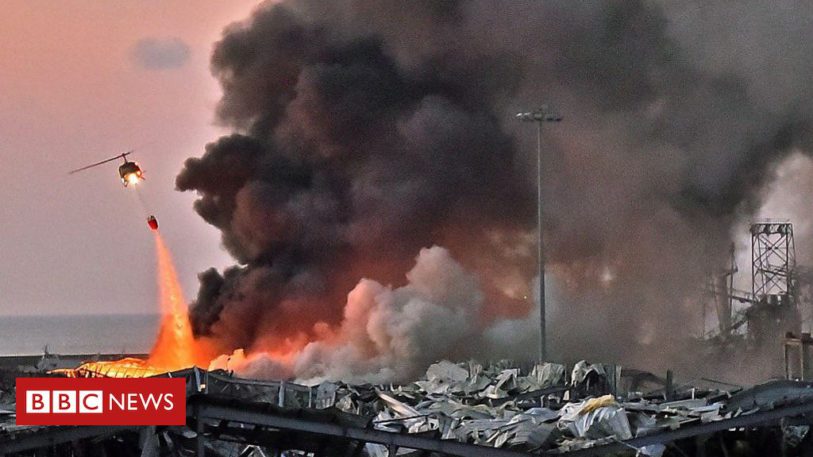An explosion of 2,750 tonnes of ammonium nitrate occured at the port of Beruit. This incident left hundreds dead, thousands injured, and hundreds of thousands of people displaced. In the prevailing COVID-19 context many complications emerged and a more sophiscated examination response to this incident was required.

Below are two presentations presented by Mr. Muralee Thummarukudy and Margherita Fanchiotti, PhD on the linkage between the environment and COVID-19 and environmental reponse to the explosion.
- Environmental Linkages of COVID-19 by Muralee Thummarukudy
- Presentation on Beruit Explosion by Margherita Fanchiotti, PhD
Executive Summary
On 4 August 2020 at approximately 18:00 local time, an explosion followed by a blast occurred at the port of Beirut. According to government sources, the explosions were caused by the ignition of 2,750 tonnes of ammonium nitrate stored at one of the port warehouses. The dynamics of the event remain uncertain. As of 21 August, the official death toll stood at 180, with over 6,500 people injured and more than 300,000 displaced. The explosion left a trail of devastation, with massive damages to the most important port of Lebanon and consequent food security implications, destroyed buildings and significant disruption to basic services.
Key environmental concerns in the aftermath of the explosion included:
- Air pollution resulting from the smoke plume and toxic dust, with potential for resuspension in air with movements (clean-up, traffic, etc.) and runoff into the water supply system in the event of rains;
- Any potential secondary and cascading impacts resulting from damages to the port warehouses which were known to store chemical substances, some of which highly toxic;
- The management of the large quantities of disaster waste generated by the explosion, including the possible presence of asbestos and other hazardous waste. All of these have implications for soil and water contamination, both at the port and elsewhere.
At the request of the United Nations Resident/Humanitarian Coordinator and OCHA Country Office in Lebanon, a United Nations Disaster Assessment and Coordination (UNDAC) team was deployed to Beirut from 5 to 27 August. The UNDAC team embedded a staff member from the UNEP/OCHA Joint Environment Unit (JEU). An Emergency Operations Cell was established to coordinate international response, in support of national efforts. As part of the international coordination structure, an Environment Cell, led by the JEU staff member, was created to ensure environmental coordination.
The main objective of the mission was to coordinate all international environmental response, leveraging from expertise dispatched across different teams of responders, in support of national efforts; provide technical advice to rapidly identify, assess and mitigate any acute environmental risks following the event, with an emphasis on those that posed immediate life-threatening risks to humans (both local communities and responders); advise on required follow-up actions in the short-, medium- and long-term; promote the early integration of environmental considerations in humanitarian assessments and overall response efforts; facilitate knowledge sharing and information exchange among national and international counterparts on environmental matters; and deliver recommendations accordingly.
As a result of the mission, the hazardous materials found at the port during the immediate response phase have been mapped and advice on rapid mitigation of related acute environmental risks was provided in real-time and actioned, to prevent cascading negative humanitarian and environmental impacts. Training on dealing with asbestos and other hazardous waste during ongoing clean-up operations was provided to environmental NGOs to raise awareness. Further assessments are required, including on soil and water contamination, to make sure that all threats are identified, to understand any actual or potential cascading risks and to restore safety.
Preliminary findings from the immediate response phase have informed the development of a comprehensive disaster waste management strategy, for which funding has been secured by the European Union. The mission outcomes showed that special considerations on hazardous waste, including asbestos, toxic dust and any other residual chemical substances, should be incorporated into this strategy and any ongoing clean-up efforts should be linked to it. The strategy will aim at minimizing the generation of waste, promoting reusing and recycling of non-hazardous waste to the extent possible, while ensuring adequate removal of contaminated products. Coordination has been facilitated across relevant national and international stakeholders to ensure that port clearance as well as recovery/reconstruction efforts across the city take into proper account the substantial residual risk linked to the presence of hazardous materials, only some of which have been found to date, and ensure adequate treatment and disposal.
The incident further highlighted the opportunity to enhance readiness for any similar events in the future and provides lessons learnt for safety at commercial ports globally.
Supporting Links